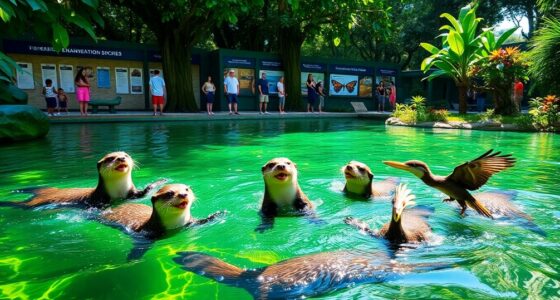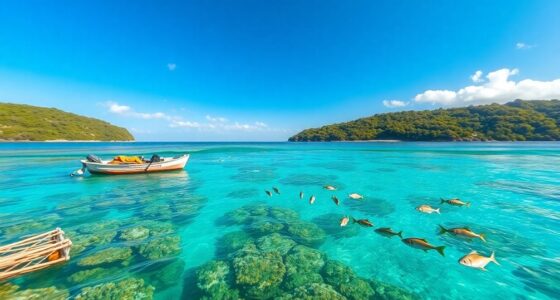Marine conservation is crucial for protecting our oceans and the vast biodiversity they support. With over 80% of the planet’s species living in marine ecosystems, ensuring their health is vital for our planet’s balance. However, climate change, pollution, and overfishing threaten these delicate habitats. By promoting Marine Protected Areas (MPAs) and sustainable practices, you can help safeguard these environments. You’ll discover how innovative technologies and community engagement play a significant role in these efforts.
Key Takeaways
- Marine ecosystems are vital for biodiversity and climate regulation, absorbing 30% of CO2 emissions and supporting numerous species.
- Protecting 30% of oceans by 2030 is crucial for preserving marine habitats and biodiversity, as emphasized in global initiatives.
- Climate change, pollution, and overfishing are major threats to marine life, necessitating urgent conservation measures and sustainable practices.
- Marine Protected Areas (MPAs) enhance ecosystem resilience and support local economies through sustainable fishing and tourism.
- Community engagement and innovative technologies, like satellite monitoring and citizen science, are essential for effective marine conservation efforts.
The Importance of Marine Ecosystems
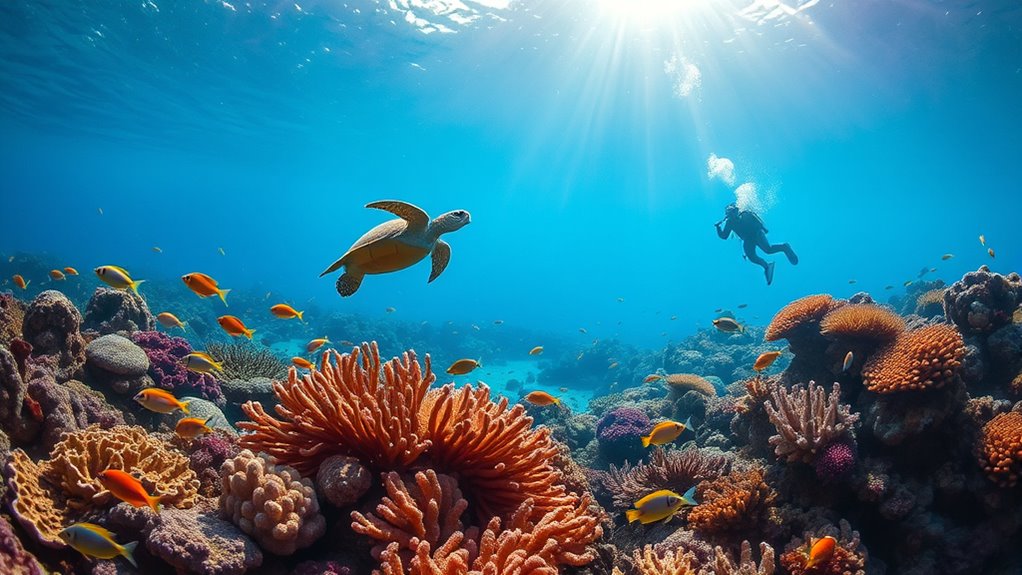
Marine ecosystems are vital not just for their beauty but for the essential roles they play in our world. They host over 80% of the planet’s biodiversity, with coral reefs supporting nearly 25% of all marine species despite occupying less than 1% of the ocean floor. This diversity fosters resilience, allowing ecosystems to maintain balance amid environmental changes. The variety of species aids in crucial processes like nutrient cycling and carbon sequestration, making marine biodiversity essential for maintaining ecosystem health. Additionally, healthy ecosystems provide essential services such as clean air and water, further emphasizing the importance of preserving marine environments.
Furthermore, marine environments contribute significantly to climate regulation, absorbing about 30% of CO2 emissions and producing half of the oxygen we breathe. The carbon sequestration capabilities of oceanic ecosystems play a key role in mitigating climate change. Predictive modeling can also help in monitoring the health of these ecosystems by forecasting changes based on historical data. Recognizing the importance of these ecosystems is key to ensuring their protection for future generations and the health of our planet.
Key Threats Facing Our Oceans

While the beauty of the ocean captivates many, its health is threatened by a range of serious issues. Climate change is causing rising sea levels and warming waters, leading to coral bleaching and altered species migrations. Additionally, oceans absorb 23% of human-caused CO2 emissions, exacerbating the impacts of climate change on marine life. The increase in harmful pollutants released through various activities also contributes to declining water quality, affecting marine biodiversity. Furthermore, young tennis prodigies inspire a new generation to appreciate and advocate for ocean conservation. Regular monitoring of marine ecosystems is essential to understand and mitigate these changes.
Pollution, particularly from plastics, poses significant risks to marine life, with microplastics causing harm through ingestion. Overfishing destabilizes ecosystems, as a third of global fish stocks are overfished, and harmful fishing practices further exacerbate the problem. Habitat destruction from coastal development and oil drilling disrupts delicate marine ecosystems. Additionally, regulatory challenges complicate efforts to manage these threats effectively. Each of these issues contributes to the decline of ocean health, making immediate action crucial for conservation.
Understanding Marine Protected Areas (MPAs)
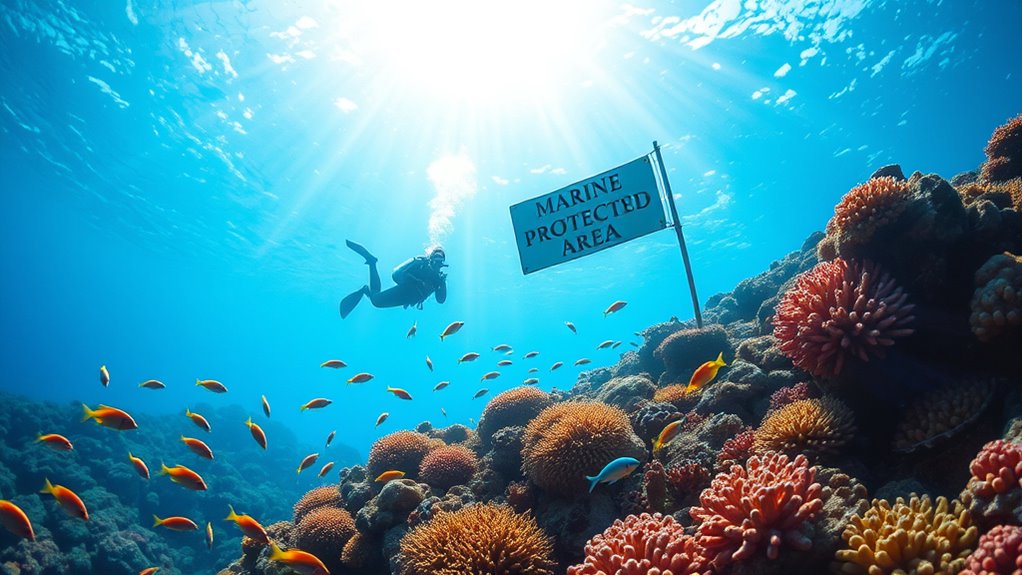
As you explore the ocean’s depths, you’ll discover that Marine Protected Areas (MPAs) play a crucial role in preserving its health and biodiversity. Defined as spaces set aside for long-term conservation, MPAs protect vital natural and cultural resources.
These areas come in various forms, including marine reserves, locally-managed areas, and no-take zones, with different rules depending on the jurisdiction. Established through legal means, effective management ensures that ecosystems can recover and thrive. In recent years, there has been an increased demand for spiritual retreats that focus on healing, which can also extend to nurturing our connection with nature. Environmental innovations in marine conservation have also emerged to enhance the effectiveness of MPAs. Additionally, the implementation of sustainable practices within MPAs can lead to improved outcomes for both marine life and coastal communities.
MPAs not only support marine biodiversity but also benefit local economies through sustainable industries and ecotourism. By serving as nurseries for fish and protecting habitats like coral reefs, MPAs contribute to food security and coastal protection, making them essential for both nature and communities. Additionally, well-designed MPAs can enhance ocean resilience against stressors like pollution and climate change.
The Impact of Climate Change on Marine Life

Climate change poses a significant threat to marine life, impacting everything from delicate coral reefs to vital fish populations. Rising sea levels increase coastal erosion and flooding, endangering habitats and breeding grounds for species like sea lions and Hawaiian monk seals. Additionally, water sources become increasingly compromised due to pollution and runoff, further threatening marine ecosystems.
Ocean acidification, caused by higher CO2 levels, weakens corals and shellfish, harming biodiversity and disrupting food webs. Marine heatwaves lead to coral bleaching and alter nutrient cycles, making ecosystems less resilient. Additionally, funding coral reef restoration projects is essential for maintaining biodiversity and ecosystem structure in marine environments.
These changes in marine environments affect fisheries and food security, putting coastal communities at risk. As species migrate and populations decline, economic dependencies on fishing and tourism face severe challenges, increasing poverty and inequality in vulnerable regions.
Innovative Technologies in Marine Conservation

Innovative technologies are transforming marine conservation by providing tools that enhance our understanding of ocean ecosystems and improve our ability to protect them.
For instance, satellite imaging helps monitor illegal fishing and track pollution hotspots. You can observe marine animal migrations in real-time through satellite tracking systems. Additionally, satellite technology enables swift responses to violations by authorities, promoting sustainable practices in ocean management. Many of these technologies, such as frost-free freezers, demonstrate how advancements can be applied to environmental monitoring to improve efficiency. Furthermore, high-quality equipment is essential for capturing audio from marine environments, allowing for better analysis of underwater ecosystems. High resolution imaging is also critical for accurately mapping and studying marine habitats.
Underwater drones map the ocean floor and study inaccessible marine life. AI-powered data analysis processes large datasets, allowing you to identify patterns crucial for conservation efforts.
Autonomous vehicles and smart trash collection systems work independently to detect pollutants and manage ocean waste efficiently.
With these advancements, you can actively participate in efforts to protect our oceans and ensure a healthier marine environment for future generations.
Engaging Communities and Policymakers
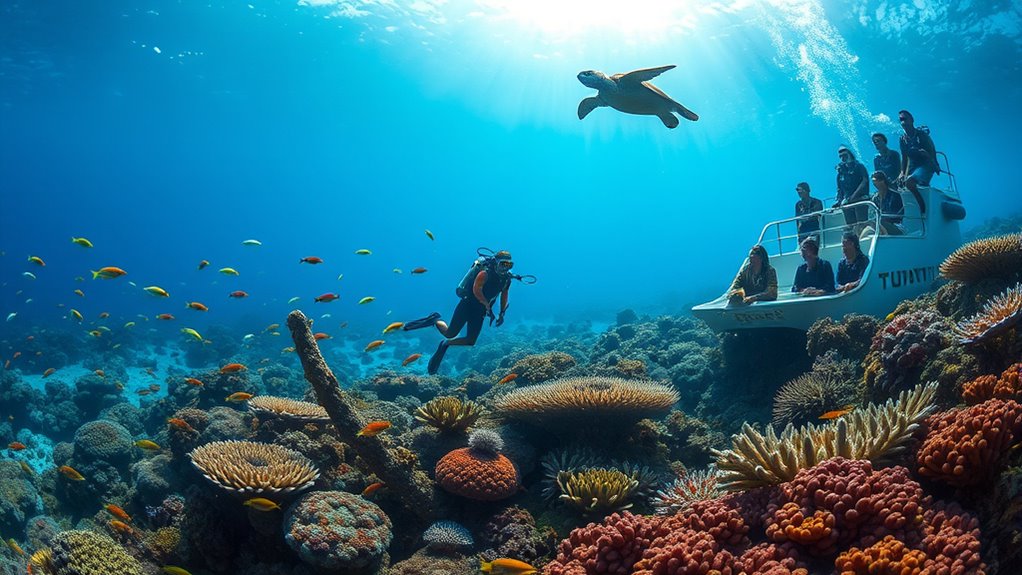
The tools and technologies advancing marine conservation are only part of the solution; engaging communities and policymakers is equally vital for effective ocean protection.
By participating in workshops and hands-on activities, you can boost awareness about marine species and their threats. Forming partnerships with NGOs and government agencies enhances conservation efforts, while providing resources empowers you to take action. Engaging communities increases the likelihood of community support for conservation policies. Additionally, effective co-parenting plans can inspire collaborative approaches to marine protection, ensuring diverse stakeholders work together towards common goals. Research shows that job growth in conservation-related fields can help sustain long-term efforts and create more employment opportunities. Engaging with community resources can further enhance support for marine conservation initiatives.
Involving your community through volunteer programs and citizen science projects fosters a sense of ownership. Advocating for legislation that prevents pollution and overfishing is crucial, too.
Support the establishment of marine protected areas and collaborate with global partners to enforce sustainable practices. Together, you can create a strong network dedicated to preserving our oceans for future generations.
Sustainable Practices for Ocean Health
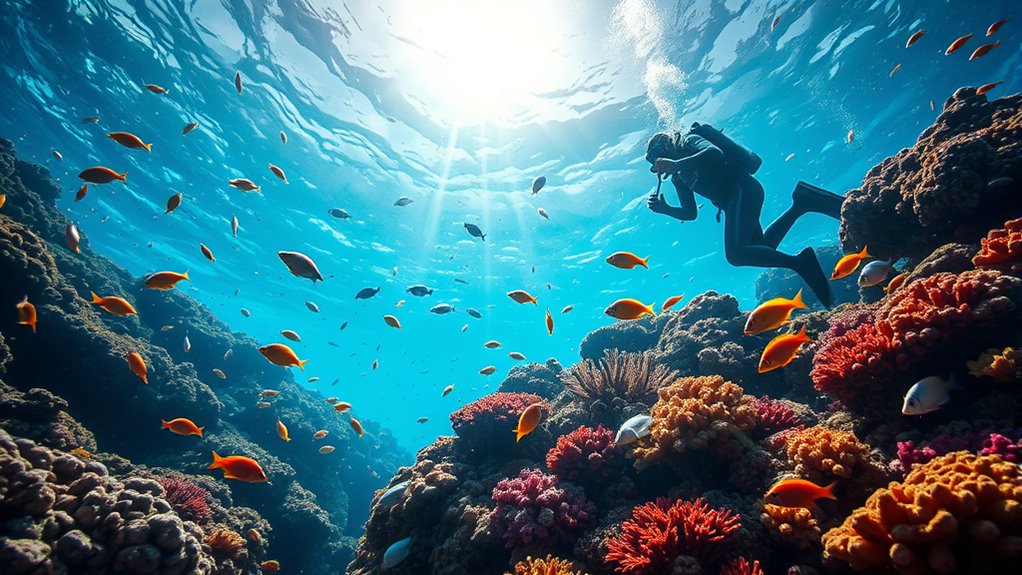
While many challenges threaten ocean health, adopting sustainable practices can make a significant difference. You can support sustainable seafood by choosing certified fisheries, like those recognized by the Marine Stewardship Council, ensuring your purchases promote responsible management. Additionally, by avoiding dishes that include protected species, you help safeguard vulnerable marine life. Addressing plastic pollution is crucial too. Opt for sustainable alternatives and advocate for circular economy practices to minimize single-use plastics. Support public awareness campaigns that highlight the impact of plastic on our oceans. Lastly, consider the importance of Marine Protected Areas (MPAs) in preserving habitats and fostering biodiversity. Healthy ocean ecosystems are vital for a healthy planet, and by embracing these practices, you contribute to a healthier ocean and a more sustainable future for marine ecosystems. Furthermore, engaging in mindfulness practices can help raise awareness about the importance of ocean conservation. To further support these initiatives, consider becoming a Certified Protection Professional (CPP), which can enhance your credibility in advocating for marine conservation. Remember that essential oils can also play a role in promoting wellness and reducing stress while you advocate for the ocean’s health.
Global Targets for Marine Conservation
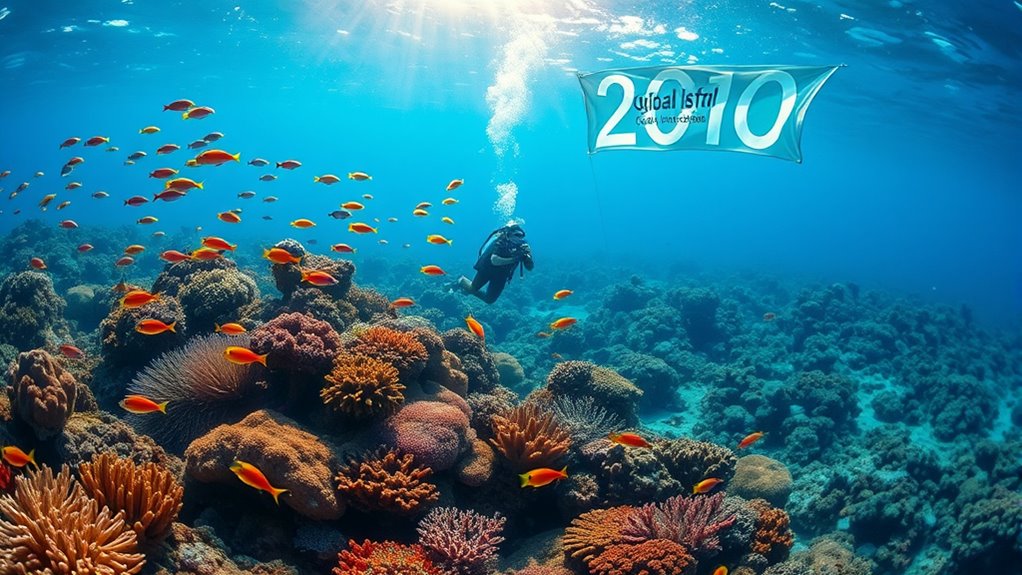
Sustainable practices for ocean health lay the groundwork for ambitious global targets in marine conservation. The UN Sustainable Development Goals (SDGs) emphasize conserving and sustainably using our oceans.
Currently, only 8.3% of the ocean is designated as Marine Protected Areas (MPAs), with just 2.8% effectively protected. To meet the Kunming-Montreal Global Biodiversity Framework‘s goal of protecting 30% of land and ocean by 2030, nations must step up efforts. Only 19 countries and the EU have submitted national biodiversity strategies with marine targets, highlighting the need for broader participation. Investment in conservation is crucial as it can provide the necessary funding and resources to support these initiatives. Additionally, renewable energy sources can help reduce pollution in marine environments, supporting healthier ecosystems. Emerging technologies can also play a significant role in monitoring and enforcing conservation efforts.
Countries like Monaco and Palau lead the way, but many governments struggle with funding and enforcement. Overfishing, pollution, and climate change threaten these ecosystems.
Frequently Asked Questions
How Can Individuals Contribute to Marine Conservation Efforts?
You can contribute to marine conservation efforts by reducing your plastic usage, opting for reusable products, and properly disposing of waste.
Participate in local clean-up events to help maintain healthier environments. Support sustainable seafood choices and eco-friendly products to lessen your impact.
Get involved in community outreach and raise awareness about marine issues. By donating, volunteering, or advocating for policy changes, you can play a key role in protecting our oceans.
What Are the Economic Benefits of Healthy Marine Ecosystems?
Imagine a world where thriving oceans boost your economy—sounds enticing, right?
Healthy marine ecosystems create jobs in fisheries, tourism, and renewable energy, fueling local economies. They also save costs by acting as natural barriers against disasters, reducing your infrastructure expenses.
Plus, sustainable practices can open doors to new markets and green financing. By supporting these ecosystems, you’re not just protecting nature; you’re investing in a prosperous future for yourself and your community.
How Do MPAS Differ From Traditional Fishing Zones?
MPAs differ from traditional fishing zones by prioritizing conservation over exploitation.
In MPAs, you’re protecting biodiversity and ensuring sustainable fish populations, while traditional zones allow for unrestricted fishing, often leading to overfishing and habitat destruction.
MPAs create safe havens for marine life, promoting recovery and resilience, whereas traditional zones struggle with depleted resources.
Essentially, you can think of MPAs as long-term safeguards, while traditional zones are more about immediate economic gain without protection.
What Role Do Local Communities Play in Marine Conservation?
Local communities play a crucial role in marine conservation by driving initiatives that protect vital ecosystems.
You help create and manage Marine Protected Areas (MPAs), fostering stewardship and sustainable use of resources.
Engaging with traditional practices, you blend cultural heritage with modern science to maintain biodiversity.
Your efforts enhance resource management, ensuring healthier marine environments while also benefiting local economies through sustainable livelihoods, like eco-tourism, that align conservation with community needs.
How Can Schools Integrate Marine Conservation Into Their Curriculum?
To integrate marine conservation into your curriculum, start by incorporating cross-curricular learning, linking marine science with subjects like art and literature.
Use children’s books to engage students, and introduce hands-on activities like beach clean-ups to provide real-world experiences.
You can also utilize innovative tools, such as virtual reality, to enhance understanding.
Collaborate with local organizations and encourage field trips to local marine environments, fostering a personal connection to the ocean.
Conclusion
As you dive into marine conservation, remember that “a drop in the ocean counts.” Every action you take can ripple through our oceans, helping to protect the vibrant ecosystems that sustain life. By supporting Marine Protected Areas, embracing sustainable practices, and engaging with your community, you’re not just safeguarding the seas; you’re ensuring a healthier planet for future generations. Let’s unite our efforts and be the change our oceans desperately need. Together, we can make waves!




